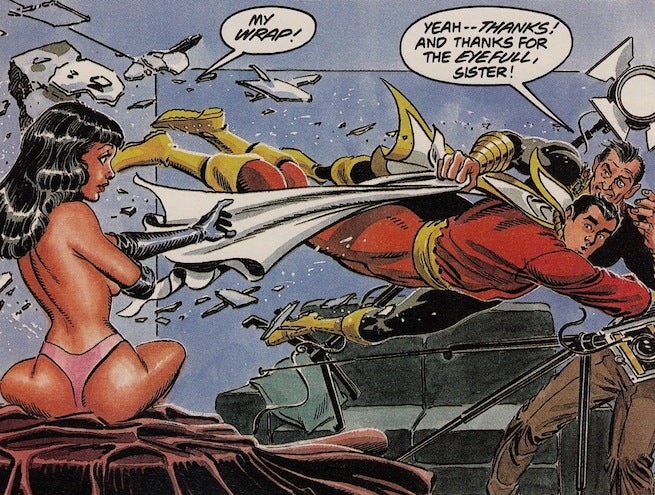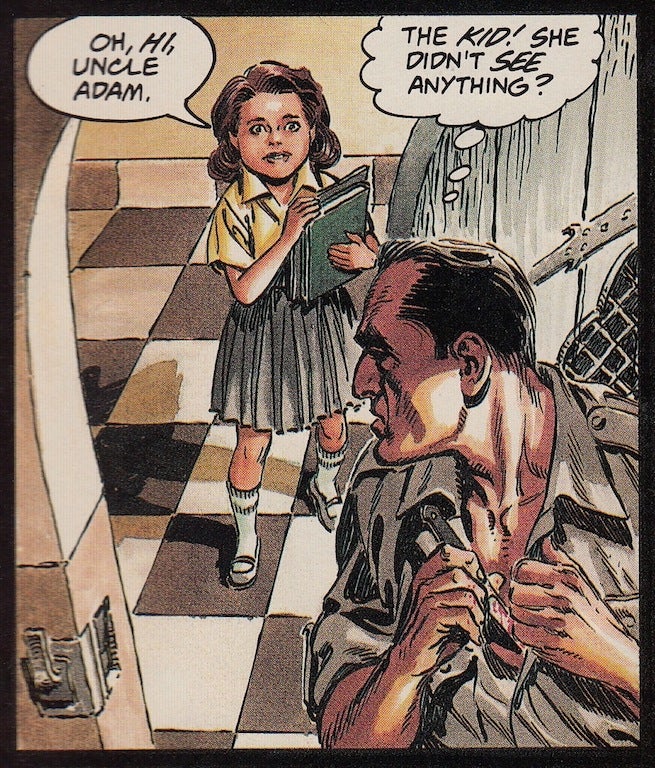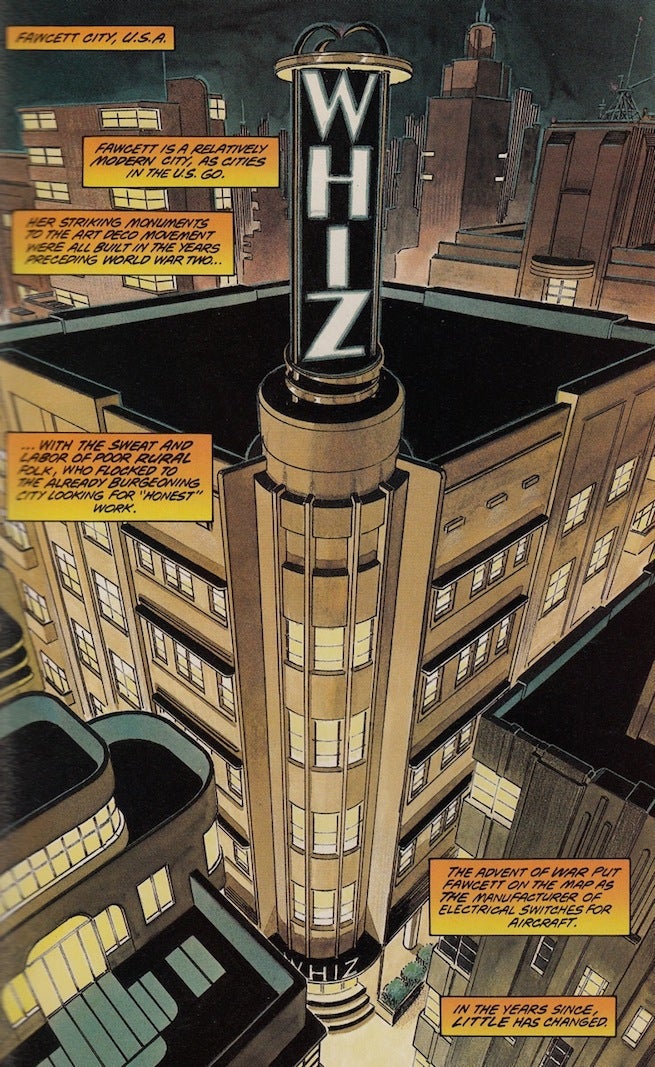90s Nirvana #4: The Power of Shazam!
“The Big Red Cheese,” better known to comic book fans as Captain Marvel or Shazam, is [...]

"The Big Red Cheese," better known to comic book fans as Captain Marvel or Shazam, is currently celebrating the 75th anniversary of his debut in 1940's Whiz Comics #1. Over the years, the character has enjoyed a complicated publication history: Fawcett Comics was forced to cease publishing Captain Marvel stories in 1953 after a lawsuit from DC alleged that the character was too close to Superman. In the 1970s, DC first licensed the character for publication in its own comics before acquiring complete ownership of Shazam and the "Marvel Family" in 1991.
Even then, DC initially struggled to find a vehicle for Captain Marvel that connected with fans. That changed in 1994 when Jerry Ordway scripted and illustrated the original graphic novel, The Power of Shazam! The comic featured a brand new origin for Marvel, which would go on to become the character's accepted origin for more than a decade. It also served as a precursor to the Power of Shazam ongoing series, written by Ordway.
Icelebration of Shazam's 75th anniversary, ComicBook.com looks at this key moment of the character's history. Is The Power of Shazam 90s Nirvana or an unspeakable mess? Let's fine out.
The Good

1. An Early Connection to Black Adam
In Ordway's graphic novel, Shazam's longtime adversary, Black Adam, is directly linked to Billy Batson's inevitable transformation into Captain Marvel. As depicted in the comic, a corrupt archaeologist, Theo Adam, kills Billy's parents while on an expedition in Egypt. After discovering that the Batson's son had been transformed into Shazam, Adam uses an ancient scarab that he recovered from the Egyptian expedition and receives his own powers when saying the word "Shazam!"
By connecting these two characters together from their respective points of origins, Ordway provides logical cause for Marvel and Adam to become such heated adversaries. In the Power of Shazam ongoing, Ordway would eventually get into Adam's ancient Egyptian heritage, but he keeps it simple here, thereby making the graphic novel an easy introduction to both characters for new readers.

2. Adam and Sivana in Cahoots
During the Fawcett years, the evil Doctor Thaddeus Sivana was introduced fairly early as a nemesis for Captain Marvel, first appearing in Whiz Comics #2. Ordway changes Sivana's backstory from crazy mad scientist to calculated/corrupt industrialist. Additionally, Sivana is revealed to be the financier for that fateful Egyptian expedition and is shown interacting with Adam, even admonishing him for killing the Batsons (rather than just stealing the relics like he asked him to without getting his hands dirty).
Ordway's incorporation of Sivana in this origin story was a clever way to introduce two of Shazam's chief adversaries in one fell swoop. And by softening the character from a moustache-twirling, cackling mad scientist, to a manipulative entrepreneur, he added a bit of nuance and complexity to Sivana.

3. Healthy Dose of Fun
Despite its inherent tragedy, the Power of Shazam makes sure not to take itself too seriously, and does feature moments of giggle-worthy fun. Like when Billy is forced to transform into his alter-ego in order to pass as his father during a parent-teacher conference (complete with his teacher flirting with him), or even the big brawl between Shazam and Adam which takes them thru a photo shoot of a scantily clad woman – the comic is not afraid to be silly, which is quite refreshing, especially when you consider how somber and dour other superhero comics were during this time period.
The Bad

1. Story Out of Time
There is something indisputably vintage and old-timey about Captain Marvel – perhaps because his peak popularity was in the Golden Age of comics. But it still comes across as odd that The Power of Shazam – a modern origin retelling by all accounts – is seemingly set in an antiquated time period, complete with newsies selling papers on the street corner, and big silver zeppelins exploding in fires. Still, there's nothing that indicates a specific time period in this comic – present day, 10 years ago, etc. – and instead the narration describes the setting as "timeless." It would have been nice for Ordway to commit to something a bit more concrete.

2. One-Dimensional Adam
Considering how Ordway and future creators (like Geoff Johns) would transform Black Adam into a multi-faceted anti-hero, The Power of Shazam is a bit over the top in its characterization of Theo Adam. Within the first few pages of the graphic novel, he is depicted as physically striking Marilyn Batson, Billy's mother – which is pretty low, even for the most one-dimensional villain. And his behavior upon his return from Egypt is that of someone who is tyrannically evil. What further muddies this choice by Ordway is the fact that Adam is clearly not in his right mind during the expedition and upon his return, probably due to the power emanating from the scarab he recovered. But rather than have him reflect on his behavior, be scared by it, etc., he just puts his head down and charges forward. The opportunity was definitely there to establish Adam as a rich, complex character from the get-go, but that just didn't happen here.
Things that Make You Go Hmm…

1. Where are the Marvels?
Kudos to Ordway for working in Sivana and Black Adam right away, but while there are references to Billy's sister, Mary, being alive and lost somewhere, the graphic novel fails to introduce the concept of the entire Marvel Family. That just comes across as a missed opportunity to not get that out of the way early on in Shazam's continuity.

2. Easter Eggs
There are some fun little shoutouts to Captain Marvel's convoluted history, including a movie marquee that says "Whiz" (as in Whiz Comics) and other signage sporting the word "Fawcett" (as in Fawcett Comics).
Final Verdict: B+
Despite some of its questionable character choices, The Power of Shazam is a lot of fun and is a great introduction to Captain Marvel/Shazam/whatever you want to call him for readers looking to learn more about the character. The fact that Ordway's story emerged as the canonical version of Shazam, makes The Power of Shazam even more essential for the character and his fans.
0comments